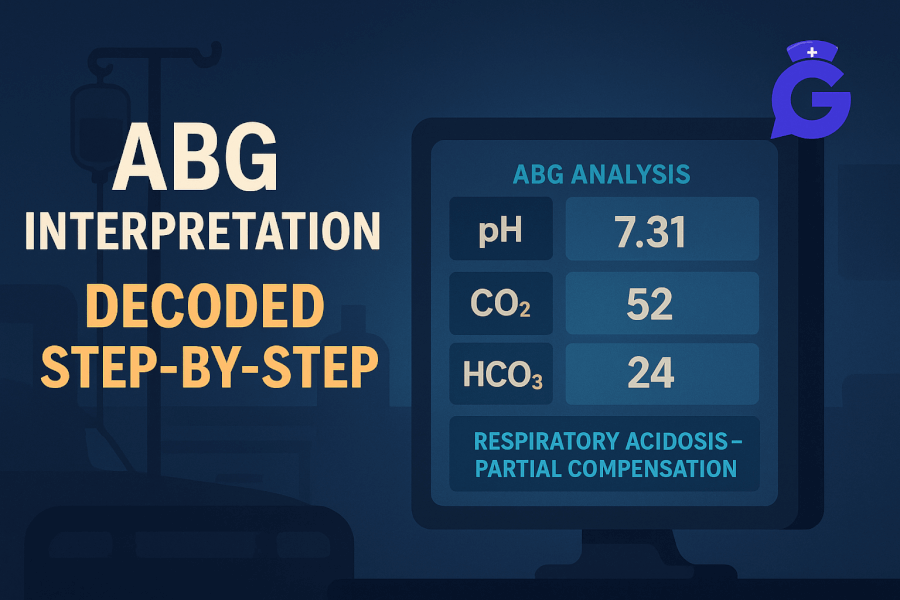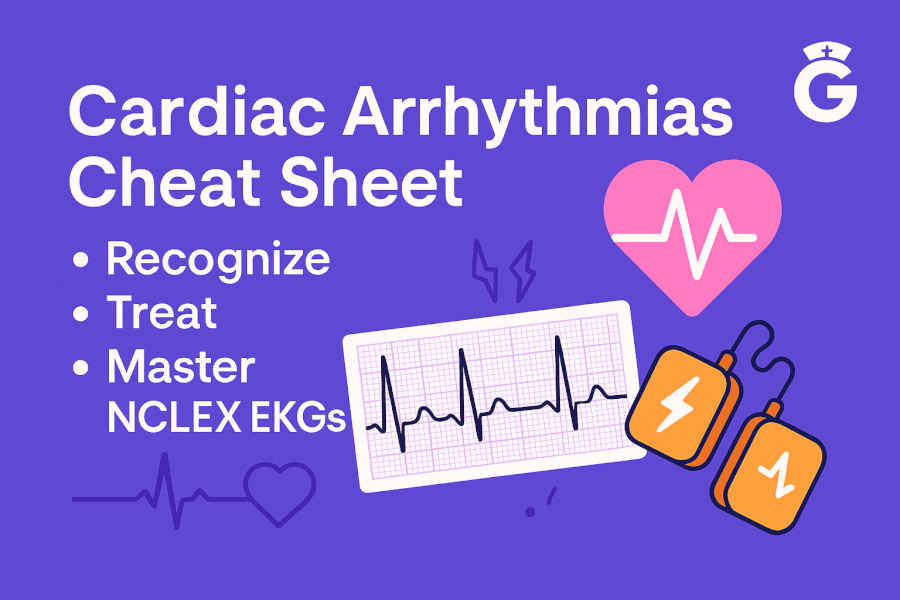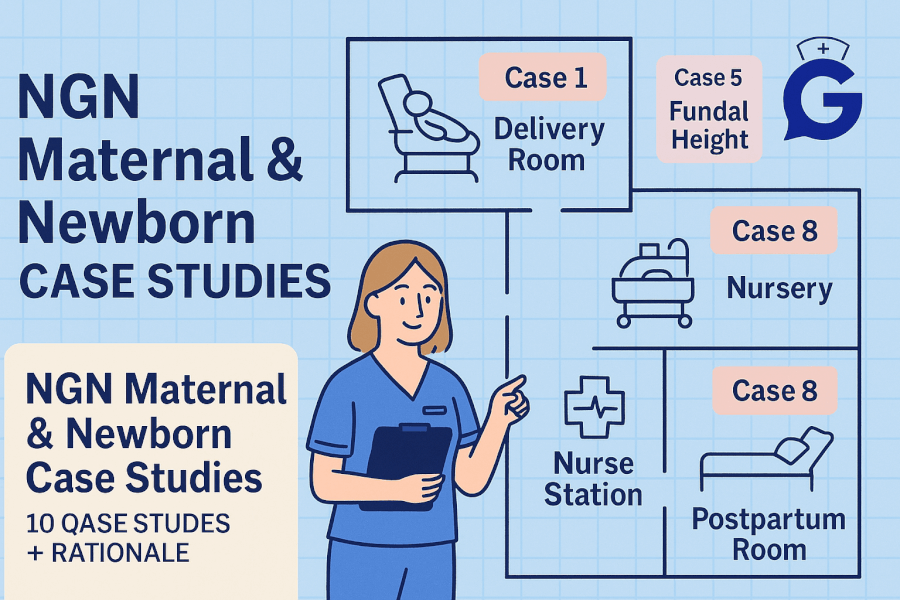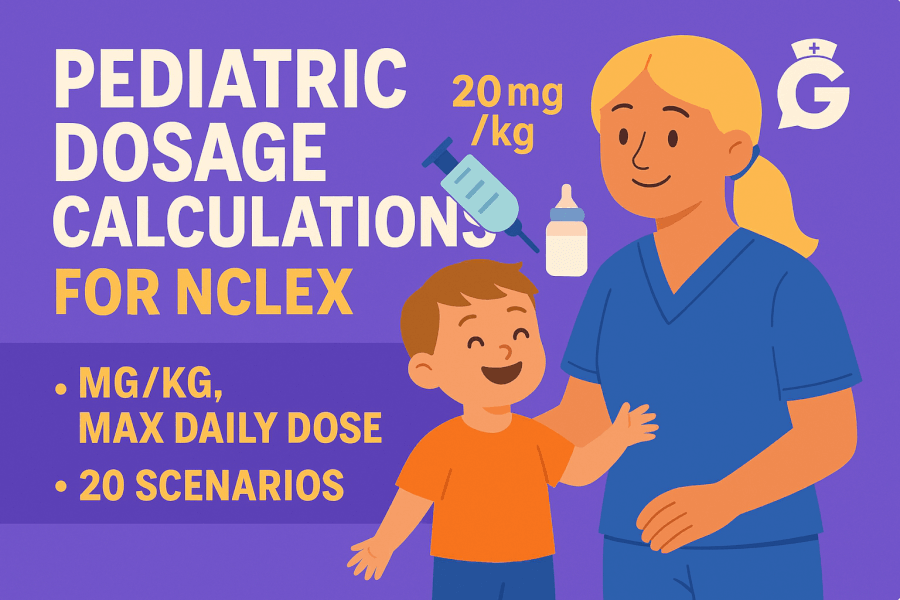Arterial blood gases tell you whether a client’s problem is mainly ventilation, oxygenation, or metabolism—and whether your actions are working. This guide gives you a simple way to read ABGs quickly, then lets you apply it to 15 realistic cases with nursing rationales you can reuse on NGN items and in clinicals.
If you need a broader lab refresher first, open the printable ranges here: Normal Lab Values for Nursing Students (2025). If case stems feel crowded, warm up with How to Read NGN Case Stems (2025) before you dive into the cases below.
Table of Contents
- How to Use This Guide
- Quick Reference: ABG Ranges and a 3-Step Method
- When to Trust Pulse Ox vs ABG
- 15 Practice Cases with Answers & Rationales
- Common Pitfalls
- NGN Tie-Ins: Action → Parameter Pairs
- FAQs
- Further Reading
🎯 Free NCLEX quiz!
Test your knowledge - new quizzes added weekly!
How to Use This Guide
- Review the quick ranges and the 3-step method.
- Work through cases in order. Say the priority out loud, then pick two actions and two parameters you’ll reassess soon.
- For NGN practice, compare your picks to the rationales and link to deeper scenarios in the NGN Case Studies hub.
Quick Reference: ABG Ranges and a 3-Step Method
Typical adult references (verify with your facility):
- pH: 7.35–7.45
- PaCO₂: 35–45 mmHg (respiratory; inverse with pH)
- HCO₃⁻: 22–26 mEq/L (metabolic; direct with pH)
- PaO₂: ~80–100 mmHg (adult, room air; age/altitude dependent)
- SaO₂: 95–100%
3-Step method
- Check pH: acidemia (<7.35) or alkalemia (>7.45).
- Decide if the primary driver is respiratory (PaCO₂) or metabolic (HCO₃⁻).
- Look for compensation and oxygenation issues, then act on what you can change fastest.
Use the Action → Parameter mindset throughout: do something that changes physiology, then choose a parameter that proves it worked (SpO₂, RR/WOB, MAP, UOP, etc.). See examples in Med-Surg Physiological Adaptation cases.
🥇Voted #1 Nursing Study Tool.
Personalized AI Tutor + Instant Answers to All Your Questions. 100% Money Back Guarantee!
When to Trust Pulse Ox vs ABG
- Pulse ox (SpO₂) is great for trending oxygenation, but it doesn’t tell you CO₂ or acid–base.
- ABG adds ventilation (PaCO₂), acid–base (HCO₃⁻), and PaO₂.
- If the clinical picture and pulse ox disagree, or the client is deteriorating, ABG wins—especially in COPD, severe asthma, suspected sepsis, or shock.
15 Practice Cases with Answers & Rationales
For each case: identify the primary disorder, likely cause, priority actions, and parameters to reassess within 10–30 minutes when appropriate.
Case 1 — Opioid hypoventilation
ABG: pH 7.24, PaCO₂ 60, HCO₃⁻ 24, PaO₂ 62
Interpretation: Acute respiratory acidosis with hypoxemia.
Likely cause: Opioid overdose or oversedation.
Priority actions: Airway/position, oxygen; prepare to reverse sedation per order and support ventilation.
Parameters: SpO₂, RR/mental status.
Case 2 — Panic hyperventilation
ABG: pH 7.52, PaCO₂ 28, HCO₃⁻ 24, PaO₂ 98
Interpretation: Acute respiratory alkalosis.
Likely cause: Anxiety or pain.
Priority actions: Calm coaching, treat pain/anxiety as ordered.
Parameters: RR, symptom relief; maintain SaO₂.
Case 3 — DKA
ABG: pH 7.22, PaCO₂ 30, HCO₃⁻ 12, PaO₂ 95
Interpretation: Metabolic acidosis with partial respiratory compensation.
Likely cause: Diabetic ketoacidosis.
Priority actions: Fluids, insulin per protocol; monitor potassium.
Parameters: Glucose, K⁺, anion gap; mental status.
Case 4 — Repeated vomiting / NG suction
ABG: pH 7.50, PaCO₂ 46, HCO₃⁻ 31, PaO₂ 96
Interpretation: Metabolic alkalosis with partial respiratory compensation.
Likely cause: Loss of gastric acid; diuretic use.
Priority actions: Replace losses (fluids/electrolytes) per order, review diuretic therapy.
Parameters: K⁺/Cl⁻, HCO₃⁻ trend, symptoms.
Case 5 — COPD baseline with acute on chronic
ABG: pH 7.32, PaCO₂ 58, HCO₃⁻ 30, PaO₂ 55
Interpretation: Chronic respiratory acidosis with acute decompensation and hypoxemia.
Likely cause: COPD exacerbation (infection or trigger).
Priority actions: Oxygen to target sats, bronchodilators/steroids per order, consider noninvasive ventilation per protocol.
Parameters: SpO₂/WOB, PaCO₂ trend, mentation.
Case 6 — Compensated COPD
ABG: pH 7.37, PaCO₂ 58, HCO₃⁻ 33, PaO₂ 70
Interpretation: Chronic respiratory acidosis with metabolic compensation.
Likely cause: Long-standing COPD.
Priority actions: Maintain baseline oxygen goals, reinforce inhaler technique and triggers.
Parameters: SpO₂ at baseline, dyspnea scale.
Case 7 — Severe asthma attack
ABG: pH 7.28, PaCO₂ 52, HCO₃⁻ 24, PaO₂ 58
Interpretation: Acute respiratory acidosis with hypoxemia.
Likely cause: Bronchospasm with air trapping.
Priority actions: Oxygen, short-acting bronchodilator, steroids per order; escalate if fatigue/confusion.
Parameters: SpO₂/WOB, peak flow if able, mental status.
Case 8 — Sepsis with lactic acidosis
ABG: pH 7.18, PaCO₂ 32, HCO₃⁻ 12, PaO₂ 84; lactate trending up
Interpretation: Metabolic acidosis (high-gap) with partial respiratory compensation.
Likely cause: Septic shock.
Priority actions: Sepsis bundle—fluids, antibiotics per order; support perfusion.
Parameters: MAP/urine output, lactate trend.
Case 9 — Diarrhea with bicarbonate loss
ABG: pH 7.30, PaCO₂ 32, HCO₃⁻ 16, PaO₂ 96
Interpretation: Metabolic acidosis (non-gap) with respiratory compensation.
Likely cause: GI bicarbonate loss.
Priority actions: Fluids/electrolytes, treat cause; monitor for dehydration.
Parameters: HCO₃⁻/K⁺, cap refill/HR, UOP.
Case 10 — Salicylate toxicity (mixed)
ABG: pH 7.35, PaCO₂ 20, HCO₃⁻ 12, PaO₂ 100
Interpretation: Mixed respiratory alkalosis + metabolic acidosis (near-normal pH).
Likely cause: Aspirin overdose.
Priority actions: Toxicology protocol; consider bicarbonate infusion to alkalinize urine as ordered; monitor glucose/temperature.
Parameters: ABG trend, salicylate levels, mentation.
Case 11 — Pulmonary embolism (early)
ABG: pH 7.48, PaCO₂ 30, HCO₃⁻ 23, PaO₂ 64
Interpretation: Acute respiratory alkalosis with hypoxemia.
Likely cause: PE causing V/Q mismatch and hyperventilation.
Priority actions: Oxygen, rapid evaluation; anticipate anticoagulation per order.
Parameters: SpO₂, hemodynamics, symptom relief.
Case 12 — High altitude exposure
ABG: pH 7.47, PaCO₂ 30, HCO₃⁻ 22, PaO₂ 60 (room air)
Interpretation: Respiratory alkalosis with expected mild metabolic compensation; hypoxemia.
Likely cause: Hyperventilation at altitude.
Priority actions: Oxygen if symptomatic; gradual acclimatization.
Parameters: SpO₂, symptoms (headache, dyspnea).
Case 13 — Post-op hypoventilation
ABG: pH 7.29, PaCO₂ 50, HCO₃⁻ 24, PaO₂ 68
Interpretation: Acute respiratory acidosis with hypoxemia.
Likely cause: Residual anesthetic/sedative effect, pain-limited breathing.
Priority actions: Upright positioning, oxygen; encourage deep breathing/incentive spirometry; evaluate analgesia strategy.
Parameters: SpO₂, RR/WOB, sedation scale.
Case 14 — Hyperemesis gravidarum
ABG: pH 7.49, PaCO₂ 43, HCO₃⁻ 31, PaO₂ 98
Interpretation: Metabolic alkalosis.
Likely cause: Prolonged vomiting.
Priority actions: Fluids/electrolytes, antiemetics per order; nutrition support.
Parameters: HCO₃⁻/K⁺/Cl⁻, weight/IOs, symptom control.
Case 15 — ARDS (severe hypoxemia)
ABG: pH 7.41, PaCO₂ 38, HCO₃⁻ 24, PaO₂ 54 on high FiO₂
Interpretation: Refractory hypoxemia; near-normal acid–base.
Likely cause: Diffuse alveolar damage (e.g., sepsis, aspiration).
Priority actions: Advanced oxygenation/ventilation per protocol; prone positioning as ordered; hemodynamic support.
Parameters: PaO₂/SpO₂ at given FiO₂, WOB/vent settings, hemodynamics.
Want more practice that mirrors exam screens? Jump to the NGN Case Studies (2025) hub and pair these ABG patterns with full scenarios.
Common Pitfalls
- Picking actions that don’t change physiology. Choose something that affects ventilation, perfusion, or metabolic load.
- Ignoring oxygenation. PaCO₂/HCO₃⁻ don’t replace PaO₂/SpO₂—treat hypoxemia first.
- Forgetting potassium. Correcting acidosis/alkalosis shifts K⁺ and can trigger arrhythmias.
- Over-relying on a single number. Read the trend and the clinical story, not just the lab.
NGN Tie-Ins: Action → Parameter Pairs
- Ventilation failure (CO₂ rising, pH falling): open airways/support ventilation → reassess RR/WOB, PaCO₂/SpO₂.
- Hypoxemia (low PaO₂/SaO₂): oxygen and positioning → reassess SpO₂/PaO₂ and WOB.
- High-gap metabolic acidosis (sepsis/DKA): fluids + treat cause → reassess MAP/urine output, lactate or anion gap, mental status.
- Metabolic alkalosis (vomiting/diuretics): replace Cl⁻/K⁺, review meds → reassess K⁺/Cl⁻/HCO₃⁻ and symptoms.
FAQs
Do I need to memorize exact PaO₂ cutoffs?
Know adult room-air expectations and that oxygenation targets depend on the client’s condition and protocol. Trends and clinical signs matter.
How fast should compensation happen?
Respiratory compensation for metabolic issues can start within minutes; renal compensation for respiratory problems takes hours to days.
Is a normal pH always normal?
No. Mixed disorders can “normalize” pH. Inspect PaCO₂ and HCO₃⁻ to see both sides of the equation.
Where do ABGs show up on NGN?
Often embedded in matrix/grid or bow-tie stems as cues. Start by stating the priority, then select actions and parameters that match it.







